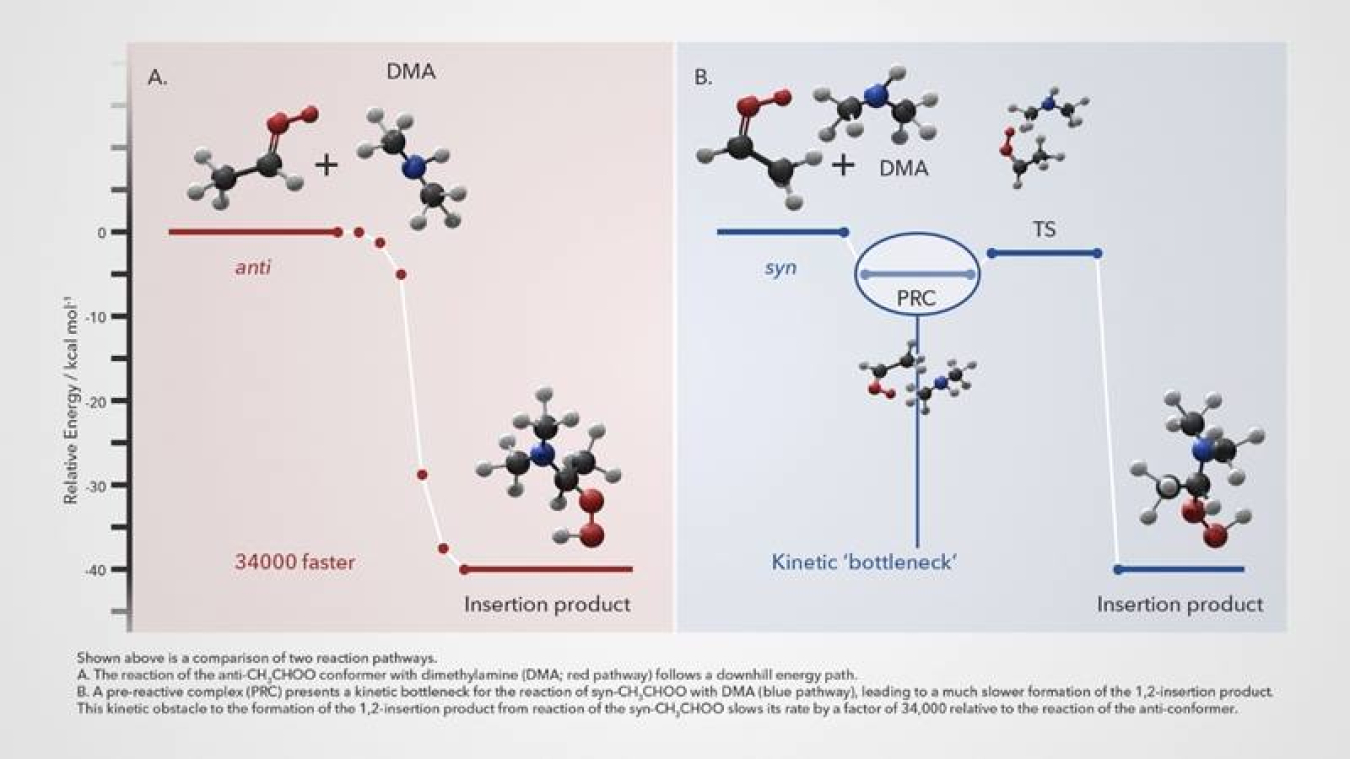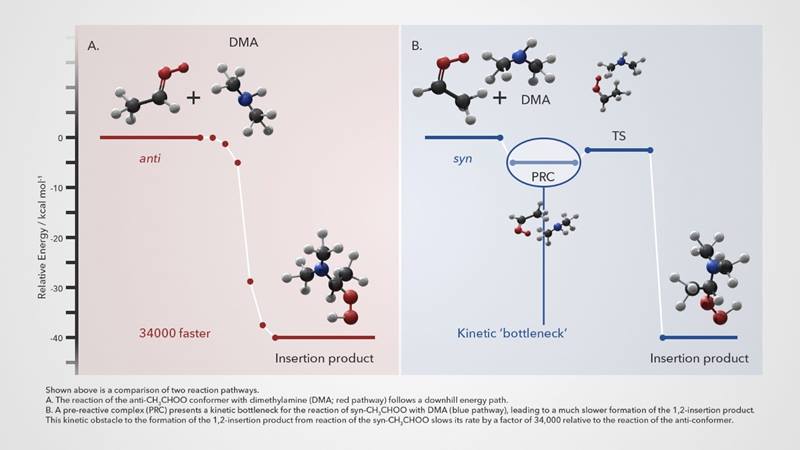
The Science
Secondary organic aerosol (SOA) is a type of air pollution that affects health, air quality, and the global climate. SOA forms when ammonia and related chemicals called amines react with oxygenated species. Oxygenated species such as ozone and hydroxyl radicals, also known as free radicals, are a type of molecule that reacts very easily with other molecules in a cell. When ammonia is present when certain hydrocarbons called alkenes react with ozone, SOA increases in size and numbers. This may be due to a special carbon-oxygen molecule called a Criegee intermediate. New research found that a particular amine, dimethylamine (DMA), reacts 34,000 times faster with one version of the Criegee intermediate acetaldehyde oxide (CH3CHOO), than with another version of the same compound.
The Impact
Amines come from a huge range of sources. This includes natural processes in the oceans, but amines also come from industry, herds of domesticated animals, combustion, and industry. Indoors, amines can come from cooking and even cleaning. The SOAs that form when amines react with oxygenated species are important for health and the environment. For example, SOAs can affect atmospheric radiation and thus the Earth’s climate. They can also damage human and animal lungs. This makes it critical that scientists understand the differences in the reaction pathways for different Criegee intermediates and what those differences mean for SOAs.
Summary
Researchers from Argonne National Laboratory, Sandia National Laboratories, the University of Pennsylvania, and the Jet Propulsion Laboratory used a technique known as synchrotron-multiplexed photoionization mass spectrometry to follow the conformer dependence of the reaction of acetaldehyde oxide (CH3CHOO) with dimethylamine (DMA). Asymmetric Criegee intermediates of CH3CHOO exist as distinct conformers where the terminal oxygen points towards either the carbon side chain or the hydrogen substituent, resulting in the syn- or anti- conformer. The experiments were carried out using Sandia multiplexed photoionization mass spectrometer (MPIMS), interfaced with the tunable synchrotron radiation of the Chemical Dynamics beamline at the Advanced Light Source, a Department of Energy user facility at Lawrence Berkeley National Laboratory. The researchers used tunable-vacuum ultraviolet photoionization probing of anti- or anti- + syn- CH3CHOO to confirm the strong conformer dependence of the reaction.
The researchers followed direct experiments with the conformers with high-level calculations of the electronic structures of the conformers, which were aimed at quantifying the reaction energetics of the acetaldehyde oxide + dimethyl amine reaction. The mathematical modelling showed that both conformers of acetaldehyde oxide react with DMA by following an energetically downhill kinetic mechanism. While the reaction path of the anti conformer is barrierless, the syn conformer has a submerged ‘first-order saddle point’ trough of -2.2 kcal mol–1 that acts as a kinetic bottleneck, slowing down the reaction. The researchers conclude that the conformer-dependent reactivity will result in a rate coefficient of DMA with anti- CH3CHOO that is predicted to exceed that for the reaction with syn- CH3CHOO by a factor of approximately 34,000. The dramatically different rates of reaction might lead to different fates for the conformers of asymmetric Criegee intermediates in chemically complex environments. As an example, different conformers will display a different propensity to form aerosol precursors both in Earth’s atmosphere and in indoor environments. The researchers propose that future studies should explore the impact of water complexation of the reaction mechanism and conformer dependence on the reaction of CH3CHOO with DMA.
Contact
Rebecca Caravan
Chemical Sciences and Engineering Division, Argonne National Laboratory
[email protected]
Funding
The contributions of Argonne National Laboratory, Sandia National Laboratories, and the University of Pennsylvania were supported by the Department of Energy (DOE) Office of Science, Office of Basic Energy Sciences, Division of Chemical Sciences, Geosciences and Biosciences. The contributions of the Jet Propulsion Laboratory were supported by the National Aeronautics and Space Administration Upper Atmosphere Research and Tropospheric Chemistry program. This research used resources of the Advanced Light Source, a DOE Office of Science User Facility.
Publications
Vansco, M.F., et al., Dramatic Conformer-Dependent Reactivity of the Acetaldehyde Oxide Criegee Intermediate with DimethylamineVia a 1,2-Insertion Mechanism. The Journal of Physical Chemistry A 126 (5), 710-719 (2022). [DOI: 10.1021/acs.jpca.1c08941]
Scraped from https://www.sourcearu.com




